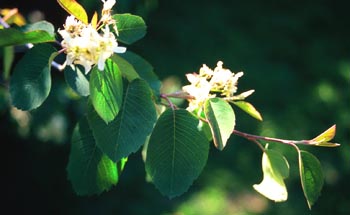Utah Serviceberry

Common Name(s):
Utah Serviceberry
Serviceberry
Sarviceberry
Scientific Name:
Amelanchier utahensis Koehne
Scientific Name Synonyms:
None known
Symbol:
AMUT
Description:
Life Span: Perennial
Origin: Native
Season: Cool
Growth Characteristics: Utah serviceberry is a small tree or large shrub that is much branched or in clumps. Its average height at maturity is about 15 feet. Individual stems my average 5 to 6 inches in diameter. Reproduction is by seed or by sprouting from the root crown.
Flowers/Inflorescence: The flowers of Utah serviceberry have white petals and grow in small clusters. In early spring, while in bloom, the entire plant is snowy white. Flowers April through June.
Fruits/Seeds: Seeds are formed in small apple-like pomes that are brown to black when ripe. The mealy portions of this fruit are juicy, sweet, and palatable.
Leaves: An elliptical shaped leaf, with coarsely toothed margins, especially along the upper half of the blade. The leaf blades grow to about 1-½ inches in length, and are covered with fine, soft hairs. They fall from the twigs after turning brown in autumn.
Stems: Twigs are round, rather coarse, and somewhat covered with tiny hairs. The bark is mostly smooth and gray colored. The wood is soft and light.
Ecological Adaptions:
Utah serviceberry is widely scattered throughout the state. It is common in the more arid areas in canyons, rocky areas, and foothills, usually between 3,000 and 9,000 feet in elevation. Once it is established, it tolerates drought well.
Soils: Utah serviceberry grows best on coarse to medium well-drained soils. It requires excellent drainage and is not salt tolerant.
Associated Species: Pinyon pine, ponderosa pine, quaking aspen, gambel oak, bluebunch wheatgrass, Indian ricegrass.
Uses and Management:
The fruit of Utah serviceberry is an excellent source of bird food while the foliage is good browse for both wildlife and domestic livestock. It is a very important species for mule deer in the Great Basin. It provides good forage in late winter and early spring because it leafs out and blooms earlier than associated species. Utah serviceberry also provides good ground cover for watershed protection.
Utah serviceberry has been used for fuel to a very limited degree. The fruit, both fresh and dried, was extensively used as food by Indians. The branches were used for making bows.

